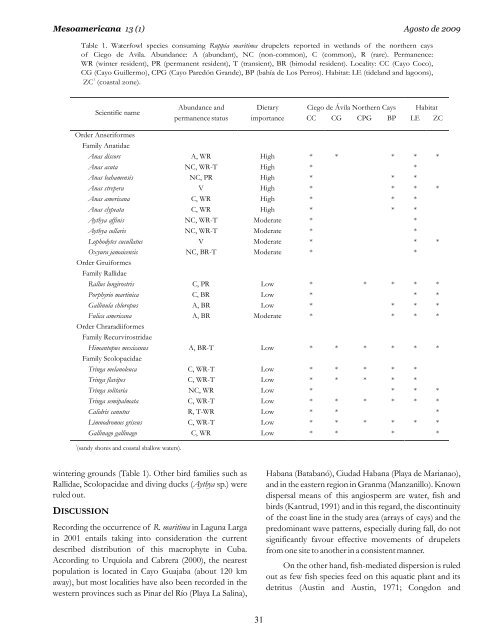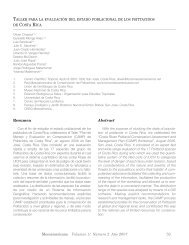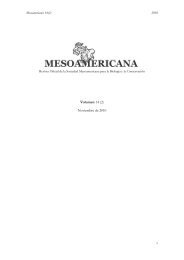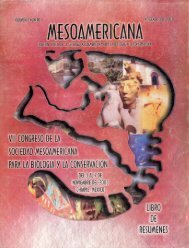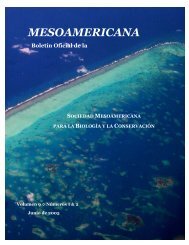MESOAMERICANA - Sociedad Mesoamericana para la BiologÃa y la ...
MESOAMERICANA - Sociedad Mesoamericana para la BiologÃa y la ...
MESOAMERICANA - Sociedad Mesoamericana para la BiologÃa y la ...
Create successful ePaper yourself
Turn your PDF publications into a flip-book with our unique Google optimized e-Paper software.
<strong>Mesoamericana</strong> 13 (1) Agosto de 2009<br />
Table 1. Waterfowl species consuming Ruppia maritima drupelets reported in wet<strong>la</strong>nds of the northern cays<br />
of Ciego de Avi<strong>la</strong>. Abundance: A (abundant), NC (non-common), C (common), R (rare). Permanence:<br />
WR (winter resident), PR (permanent resident), T (transient), BR (bimodal resident). Locality: CC (Cayo Coco),<br />
CG (Cayo Guillermo), CPG (Cayo Paredón Grande), BP (bahía de Los Perros). Habitat: LE (tide<strong>la</strong>nd and <strong>la</strong>goons),<br />
1<br />
ZC (coastal zone).<br />
wintering grounds (Table 1). Other bird families such as<br />
Rallidae, Scolopacidae and diving ducks (Aythya sp.) were<br />
ruled out.<br />
DISCUSSION<br />
Scientific name<br />
Abundance and<br />
permanence status<br />
Recording the occurrence of R. maritima in Laguna Larga<br />
in 2001 entails taking into consideration the current<br />
described distribution of this macrophyte in Cuba.<br />
According to Urquio<strong>la</strong> and Cabrera (2000), the nearest<br />
popu<strong>la</strong>tion is located in Cayo Guajaba (about 120 km<br />
away), but most localities have also been recorded in the<br />
western provinces such as Pinar del Río (P<strong>la</strong>ya La Salina),<br />
Dietary<br />
importance<br />
Ciego de Ávi<strong>la</strong> Northern Cays<br />
CC CG CPG BP<br />
Habitat<br />
LE ZC<br />
Order Anseriformes<br />
Family Anatidae<br />
Anas discors A, WR High * * * * *<br />
Anas acuta NC, WR-T High * *<br />
Anas bahamensis NC, PR High * * *<br />
Anas strepera V High * * * *<br />
Anas americana C, WR High * * *<br />
Anas clypeata C, WR High * * *<br />
Aythya affinis NC, WR-T Moderate * *<br />
Aythya col<strong>la</strong>ris NC, WR-T Moderate * *<br />
Lophodytes cucul<strong>la</strong>tus V Moderate * * *<br />
Oxyura jamaicensis NC, BR-T Moderate * *<br />
Order Gruiformes<br />
Family Rallidae<br />
Rallus longirostris C, PR Low * * * * *<br />
Porphyrio martinica C, BR Low * * *<br />
Gallinu<strong>la</strong> chloropus A, BR Low * * * *<br />
Fulica americana A, BR Moderate * * * *<br />
Order Chraradiiformes<br />
Family Recurvirostridae<br />
Himantopus mexicanus A, BR-T Low * * * * * *<br />
Family Scolopacidae<br />
Tringa me<strong>la</strong>noleuca C, WR-T Low * * * * *<br />
Tringa f<strong>la</strong>vipes C, WR-T Low * * * * *<br />
Tringa solitaria NC, WR Low * * * *<br />
Tringa semipalmata C, WR-T Low * * * * * *<br />
Calidris canutus R, T-WR Low * * *<br />
Limnodromus griseus C, WR-T Low * * * * * *<br />
Gallinago gallinago C, WR Low * * * *<br />
1<br />
(sandy shores and coastal shallow waters).<br />
31<br />
Habana (Batabanó), Ciudad Habana (P<strong>la</strong>ya de Marianao),<br />
and in the eastern region in Granma (Manzanillo). Known<br />
dispersal means of this angiosperm are water, fish and<br />
birds (Kantrud, 1991) and in this regard, the discontinuity<br />
of the coast line in the study area (arrays of cays) and the<br />
predominant wave patterns, especially during fall, do not<br />
significantly favour effective movements of drupelets<br />
from one site to another in a consistent manner.<br />
On the other hand, fish-mediated dispersion is ruled<br />
out as few fish species feed on this aquatic p<strong>la</strong>nt and its<br />
detritus (Austin and Austin, 1971; Congdon and


